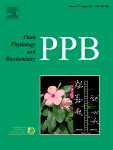Ver ítem
- xmlui.general.dspace_homeCentros Regionales y EEAsCentro Regional Buenos Aires NorteEEA San PedroArtículos científicosxmlui.ArtifactBrowser.ItemViewer.trail
- Inicio
- Centros Regionales y EEAs
- Centro Regional Buenos Aires Norte
- EEA San Pedro
- Artículos científicos
- Ver ítem
Comparative proteomic and metabolomic studies between Prunus persica genotypes resistant and susceptible to Taphrina deformans suggest a molecular basis of resistance
Resumen
The worldwide-distributed leaf peach curl disease is caused by the biotroph Taphrina deformans. To characterize the plant-fungus interaction, resistant and susceptible Prunus persica genotypes grown in the orchard were studied. Asymptomatic leaves were tested for fungal presence. In all resistant leaves analyzed the fungus was not detected. Conversely, leaves from the susceptible genotype were categorized according to the presence or absence of the
[ver mas...]
The worldwide-distributed leaf peach curl disease is caused by the biotroph Taphrina deformans. To characterize the plant-fungus interaction, resistant and susceptible Prunus persica genotypes grown in the orchard were studied. Asymptomatic leaves were tested for fungal presence. In all resistant leaves analyzed the fungus was not detected. Conversely, leaves from the susceptible genotype were categorized according to the presence or absence of the pathogen.
Comparative metabolomic analysis disclosed the metabolite composition associated with resistant and susceptible interactions, and of compounds involved in fungal growth inhibition such as chlorogenic acid, whose in vitro antifungal activity was verified in this work.
Differential proteome studies revealed that chloroplasts are important site of plant defense responses against T. deformans. Members of the Bet-v1-like family protein differentially responded to the pathogen.
Extracellular pathogenesis-related proteins, evaluated by qRT-PCR, and an enone oxidoreductase are constitutively present in leaves of resistant trees and could be related to fungal resistance.
This study is a global view of the changes in the metabolome, proteome and transcripts related to plant defense in naturally infected leaves of susceptible plants during the asymptomatic stage. Additionally, it provides clues to the successful molecular mechanisms operating in resistant plants, which neither develop the disease nor harbor the pathogen.
[Cerrar]

Fuente
Plant physiology and biochemistry 118 : 245-255. (2017)
Fecha
2017
ISSN
0981-9428
Formato
pdf
Tipo de documento
artículo
Palabras Claves
Derechos de acceso
Restringido
 Excepto donde se diga explicitamente, este item se publica bajo la siguiente descripción: Creative Commons Attribution-NonCommercial-ShareAlike 2.5 Unported (CC BY-NC-SA 2.5)
Excepto donde se diga explicitamente, este item se publica bajo la siguiente descripción: Creative Commons Attribution-NonCommercial-ShareAlike 2.5 Unported (CC BY-NC-SA 2.5)

